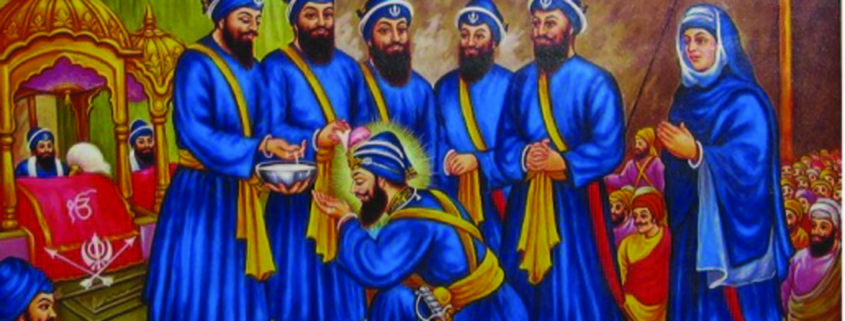On Vaisakhi day, i.e., middle of April (the first day of the New Year of the Sikhs) in 1699 at Anandpur, the Guru founded the ‘Khalsa Panth‘ by blessing the Sikhs with divine nectar (Amrit).
Trials of the Five Beloved Ones – narrated by Abu-ul-Turani
A report entitled ‘Trials of the Five Beloved Ones by Abu-ul-Turani (a spy of Aurangzeb)’ – is an eyewitness account of what happened on this day in the Divine Court of Guru Gobind Singh Ji:
Abu-ul-Turani was an agent of Aurangzeb and worked as a spy in the court of Guru Gobind Singh Ji, and used to send a daily report to the Emperor regarding daily happenings at the place.
In his report, he gave an eyewitness account of the momentous events on the Vaisakhi day of 1699.
About a mile and a half east of Batala town, on the road to Gurdaspur, lies the village of Qilla Tek Singh. Giani Buta Singh, a renowned scholar, lived there. Apart from growing crops, he also practiced traditional medicine. In his private library was found a book in Urdu written by Abu-ul-Turani.
Abu-ul-Turani – A Spy of Aurangzeb in the Guru’s Court
There was a spy named Abu-ul-Turani, sent by Aurangzeb in the court of Guru Gobind Singh Ji at Anandpur for getting day-to-day information of the events of the Guru’s Divine court. He would go to the Guru daily to pay respect in the disguise of a Brahmin, wearing a Dhoti, sacred thread (Janeu) and frontal mark (Tilak) and used to send the daily secret report of the happenings in the Guru’s Court to Aurangzeb. He shared living quarters with the Guru’s gardener, Gulaba. Every day, he would visit the Guru’s Court and, in a show of mock reverence, would fall at the Guru’s feet. Seeing his antics, the all-knowing Guru would just smile, for He could see through Turani’s hypocrisy and knew who he really was.
In his book ‘Kalgidhar Chamatkar’, Bhai Vir Singh has also made a mention of the Mughal spy.
For about a year and a half, he kept a secret watch on the Guru’s Court. In his memoirs, Abu-ul-Turani narrates the events as they unfolded on the Vaisakhi day of initiation in 1699, in his report which was sent to Aurangzeb, as follows:
The Scene at Anandpur – The Sacrifices
‘On the auspicious day, Guru Gobind Singh prepared the bowl of nectar (Amrit) at Anandpur. The gathering was thirty-five to forty thousand Sikhs. We know of four Mughal Takht – seats of power – Delhi, Agra, Lahore and Kalanaur, but the Guru’s Takht was so grand that it put the Mughal Takhts in shade.
The Guru was wearing a splendid robe, and the divine glow on his face was hard to bear. The Guru got up, drew his sword, and in a loud commanding voice, demanded, “I need the head of a Sikh.” Without a moment’s hesitation, a Sikh named Daya Ram rose and presented himself before the Guru. Then in full view of the gathering, the Tenth Guru struck a blow with the sword cutting off Daya Ram’s head. A feeling of awe engulfed the audience, most of whom were stunned into silence. The Guru got up a second time and addressed the gathering in a loud and severe voice, “I need the head of another Sikh.” Instantly, one Dharam Chand got up, went across to the Guru and bowed before him. A single stroke of the Guru’s sword severed the head of Dharam Chand from the body. Confusion and panic broke out and people started running away. In the midst of this commotion, the Guru, in a powerful voice, once again demanded a head, and one after another, Himmat Rai, Mohkam Chand, and Sahib Chand were beheaded. Some devotees fled to the Guru’s mother – Mata Gujri and narrated to her the incredible happenings in Darbar.
The Guru cleaned the bodies, by washing off the clothes on the bodies of the five Sikhs. The floor, too, was scrubbed, and all traces of blood were removed. Then the Guru of the Non-Believers (Kafirs) rearranged the severed heads and headless bodies randomly and skilfully sewed each head and body together; this took him about three hours. Each of the restored bodies was covered with a white sheet. He then sent for a stone mortar, on which He placed an iron bowl (without handles). After pouring some water into the bowl, He began to prepare the divine nectar (Aab-e-Hayat).
Then a lady from the Guru’s family came over and added something to the stirred water. The Guru of the Kafirs kept stirring the water with a dagger while reciting some hymns (Kalmas). This process continued for an hour or so. Now the Divine Nectar was ready.
Restoration to Life of the Panj Pyaras – The Blessed Beloved Five
Next, the Guru took the sheets off from the bodies, one by one. Then He sat down by the side of Daya Ram, opened his mouth and poured some nectar into it; then he sprinkled some Nectar on his hair and eyes five times. Having done so, He asked him to repeat the salutation ‘Waheguru ji ka Khalsa, Waheguru ji ki Fateh’. No sooner had the Guru said these words than Daya Ram got up and exclaimed in a loud voice ‘Waheguru ji ka Khalsa, Waheguru ji ki Fateh’. At this, the entire congregation was left dumb-founded. The thousands present held their breath, as they sat enchanted by the miracle performed by the Guru. Then one by one, the Guru roused from the dead, each slain Sikh in the same way – by pouring Nectar into the mouth, sprinkling some in the hair and in the eyes, and asking for a repetition of the salutation. The Guru then took all five into an adjoining tent. After a while, the Guru came out followed by the five Sikhs, who were now wearing new clothes. These Blessed Five, just restored to life, then stood outside the tent. And the Guru, on bent knees, asked them to bestow on Him as well, the gift of the holy Nectar. But they immediately questioned Him, wanting to know what He would offer to deserve such a priceless gift. In reply, the Guru gave His word that He would sacrifice His whole family and everything He owned for the cause of Panth (the Divine Path). Pleased with His answer, the Five Divine Ones blessed the Guru with the holy Nectar (Aab-e-Hayat) and renamed Him Gobind Singh from Gobind Rai. The word ‘Singh’ was also suffixed to the names of the five Sikhs, who became Daya Singh, Dharam Singh, Himmat Singh, Mohkam Singh and Sahib Singh.
Turani’s Transformation and Redemption
Turani further narrates: ‘I was filled with remorse, and wept bitterly for the reason that I was spying on the Guru (Divine), which I realised was a great sin, and for which I would go to hell. Following the Guru, thousands of those present took the holy nectar. When I saw this, I was unable to restrain myself. I repented what I had done and chided myself. Soon, I found myself drawn towards the Guru as if pulled by a magnetic power. I fell down at His feet and begged Him to bless me with the gift of the holy nectar. The Guru, who could undoubtedly see through my pretence, gave me a forgiving glance and patted me on the back. He then gave me the Aab-e-Hayat and blessed me with a new name – Ajmer Singh. In that instant, I was convinced that all my sins accumulated over several lives had been washed away. I enrolled myself in the Guru’s army and fought many a battle coming face to face with the forces of tyranny. I sent my last report to Aurangzeb, the Emperor. In it, I gave a detailed account of all the incredible events which took place in the Guru’s divine congregation (Diwan) and which I had been privileged to behold. In strong and clear terms, I warned the Emperor not to cross swords with the Guru, who is the incarnation of God himself on this earth and to refrain from cruelty. I told him that if he failed to heed my advice, his whole family and even his dynasty would be wiped out from the face of the earth.”
A Final Message
Turani’s report is absolutely clear that the Guru sought the heads of the ‘Five Beloved Ones’ in full view of the entire congregation, and didn’t keep anything secret. By interchanging one another’s head, the Guru liberated human beings from the distinction of caste, creed and class, thereby proving his dictum:
ਮਾਨਸ ਕੀ ਜਾਤ ਸਬੈ ਏਕੈ ਪਹਿਚਾਨਬੋ।
Maanas kee jaat sabh-ei ek-ei pehchaanbo.
(Akal Ustat)
Explanation:
Recognise the whole mankind as the Creation of the Divine Lord, irrespective of caste, creed and religion because the same Divine pervades in all.
Citation:
Extract from Sikh Faith – An Epitome of Inter-Faith for Divine Realisation,
written By Shiromani Panth Ratan Baba Iqbal Singh Ji.
Disclaimer: Images etc have been used from the available content on the net. If anyone has any objection, the same may be notified, and we gladly rectify the same.















In this age of modern science, any spiritual experience has only limited relevance to the extent of one who has such an experience. Otherwise it becomes only a religious teaching based on scriptures and literature. Today, the human beings are craving for having own experience of dimension beyond the physical five senses, but only rarest to come across in our Bharat, these days. We ought to shift our focus from Religion(s) to the Response-ability of each human being to savour the nectar(Amrit) of the Tenth Guru of Sikhs, Guru Gobind Singh Ji Maharaj. Then only the reign of purest (Khalsa Raj) can get established on this planet- Earth. WgjkaKhalsa; WgjkeFateh!